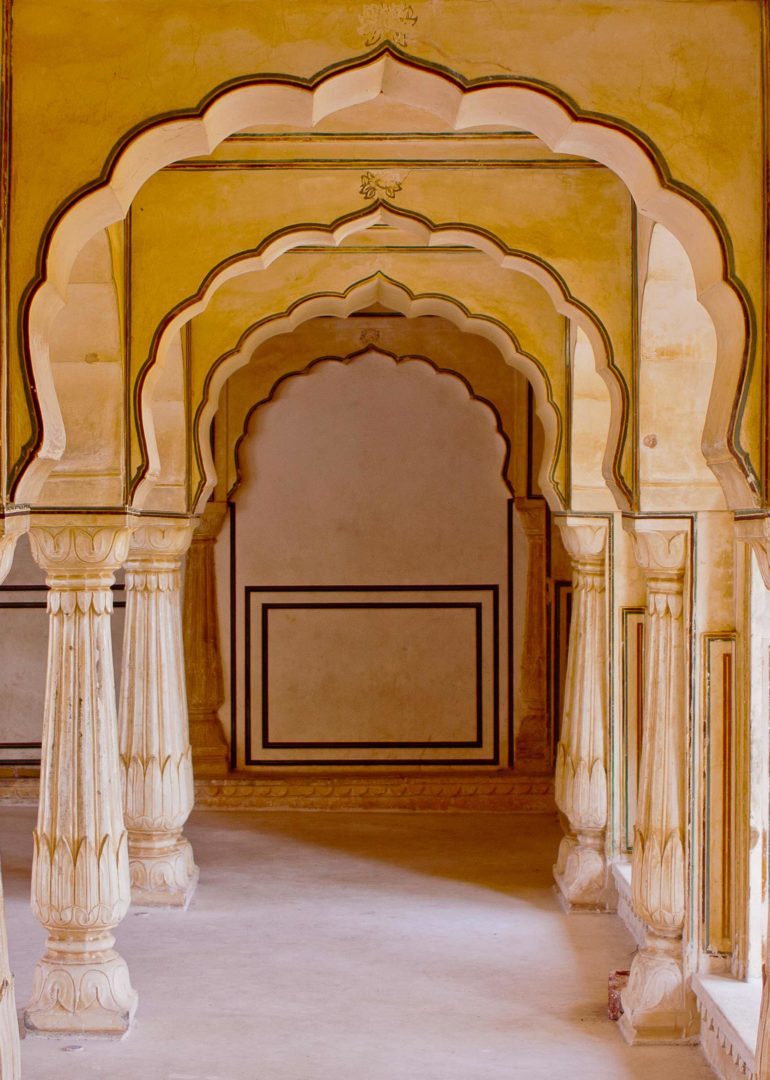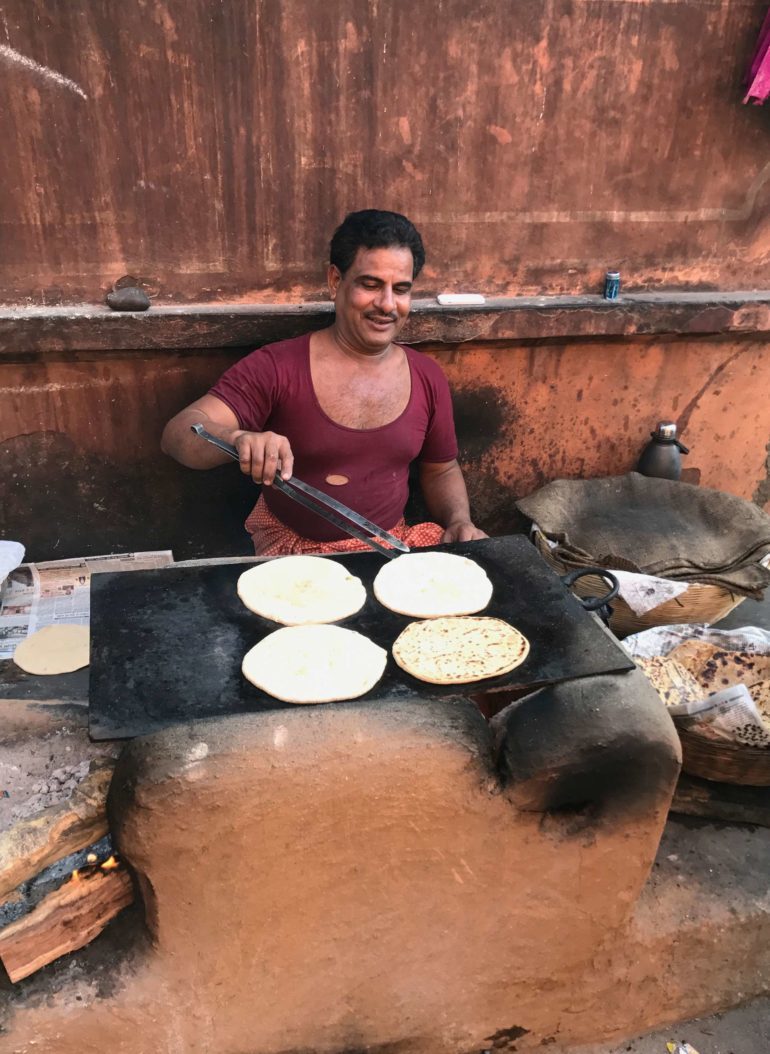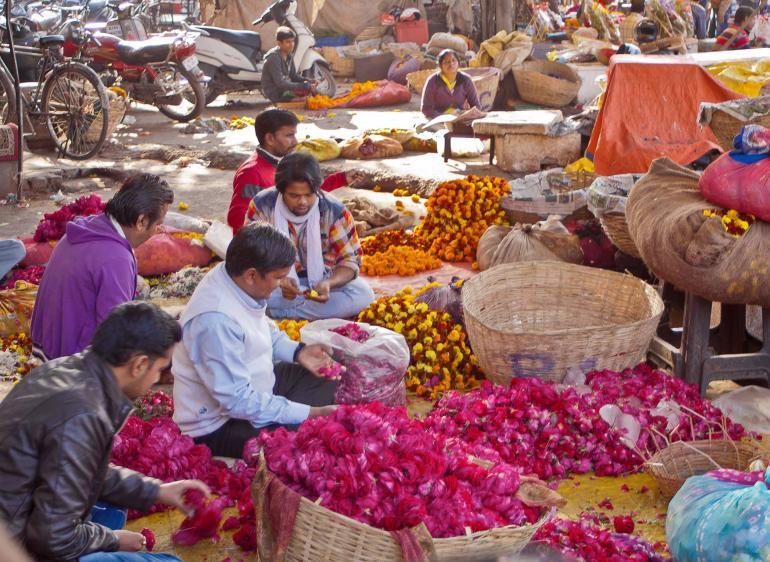With calm restored, so is our appetite. In Jaipur, you’re never far away from great street-food. We happen upon yet another sunlit square, packed with hawkers selling all kinds of mouthwatering snacks. Huge cauldrons bubble over fires, peanuts are tossed in iron pans, dough is kneaded and samosas fry in hot sizzling oil. The food here is unlike anything we have ever tasted and we fill ourselves with samosas, paratha breads and stuffed potatoes, washing this down with cool, creamy lassi. Leaving the square, we find a stall selling slices of potato fried in chili powder, giving Pringles a run for their money – but once we popped, we couldn’t stop. We fill our bags with little, beautiful, Tamil-newspaper-wrapped packets of snacks and head off for more exploration.
The Amber Fort is our destination, a gorgeous palace sitting in the middle of a lake, once the only source of water for the city. Within the walls of the fort, the architecture is different to the rest of Jaipur – here it’s more Islamic, hinting at its Moorish past. Paintings give way to intricately carved marble and inlaid patterns. The humdrum of the city dispersed somewhat and we have just monkeys for company. In a hilarious attempt to get a good monkey photo, we chase one into a great stone chamber, once home to a royal bath. Steps lead to more steps that lead to nowhere, and everywhere gradually and gracefully meets the water. It is an optical illusion much akin to the famous Escher painting.
“The street food here is unlike anything we have ever tasted”
Back in the old city, we’ve become pros. We were now easily navigating what was previously a warren of confusion to us. We pass and wave to the peanut man who tells us his nuts are the best in Jaipur, he waves back as if we were local. We turn left at the road selling flower garlands for temple-devoted pilgrims. We head straight down the road of the now closed, but still pungent fish market, dodging the puddles of fishy water. We take a shortcut past a man selling saffron, teetering carefully not to knock any of his bags over, bearing in mind that the spice is more valuable than gold, weight for weight.
Back on the main road flanked by men with bicycle rickshaws, we find the very thing that started our journey to Jaipur in the first place. There, surrounded by honking horns of cars, the screeching of Bollywood music from their speakers, in all its pink glory is The Palace Of The Winds. In this very instance, our story comes full circle. It’s even more magnificent than we had ever imagined and we stand staring at it in awe. Built just as the 18th century drew to a close, it is a great example of Hindu and Mughal fusion architecture.
The Maharajah Sarai Pratap Singh who commissioned the building insisted on its architectural features – majestic domed canopies supported by fluted pillars, so to form the perfect image of Hindu god Krishna’s crown. Surfaces are embellished with exotic lotus designs and floral patterns, romantic expressions of Hindu folklore, but a closer look reveals wide arches of geometric designs and fine filigree that is distinctly Islamic. Lattice-worked windows are meticulously carved out of the structure, revealing nearly a thousand small casements and an ingenious honeycomb design, meaning that each window is essentially only a small peephole. Why? Practicality – because of a strictly enforced Purdah system at the time of building that prohibited royal Rajput ladies from been seen by strangers or appearing in public – these miniscule windows allowed them to look out onto the streets surrounding the palace and enjoy the royal processions as they passed, but never be spotted by mere commoners. But beyond the religious reasoning, there is also another functional aspect – ventilation. It allows air to freely circulate within the closed rooms of the palace, making this sanctuary a cool but secluded haven from the outside heat.
The flamboyant and eccentric exterior of the palace is a stark contrast to what lies inside. While the outside is like a heavily embellished and intricate sari worn by the Rajasthani women, its interior takes on a pure and unpretentious beauty with no need for over-the-top finery. I take this as a fine metaphor for what Jaipur is all about. Through all the fine and colourful street scenes, grand architecture and absolute beauty, it is what lies beneath it all that really captures my heart and creates long-lasting memories for me. In Jaipur, people have a beauty and warmth that is both innocent and proud. The pride that the locals have for their city is electric – strangers will come up to you and strike up conversations about its past and present, vendors at street food stalls eagerly await your verdict as you tuck into their wares and will happily list every spice and ingredient used. Children will run up to you eager to show-off their English language skills. Rickshaw drivers will rattle off the history of every building you whizz past in their sputtering vehicles.
Jaipur is the warmest of hosts, she feeds us well on a diet of culture, architecture, spirit and samosas. But it is the warm smiles and enthusiasm of her people that is absolutely contagious and is what I shall take home with me. For me, the Palace of the Winds writes a lesson in the wind – to never ever underestimate the enormous power and beauty of a simple smile.
Photography by David Hawkins
Get out there
Do…
… carry the card of the hotel where you’re staying. It’ll give you the confidence to get lost in the city’s streets, as you’ll never be more than a beep and honk of a rickshaw away from home.
… get to Hawa Mahal early to avoid the crowds. Its pink exterior looks most majestic as the sun rises
… pack reliable footwear. It is very hot but avoid sandals and keep the Jimmy Choos for the hotel. Jaipur’s streets are dusty and pot-holed. So unless you want to slip on a mango skin or have your feet bathed in the waters of the fish market, bring trusty trainers or sneakers.
Don’t…
… forget to ask street vendors to tone down the heat of their food if you feel you can’t cope. After all, they make everything right in front of you.
… miss out on taking the opportunity to have an expert guide you through the city’s street food stalls. I was fortunate to have the head chef of the ITC Rajputana Jaipur as my guide, but there are plenty of reputable street food tours. It takes away any anxiety about hygiene and allows you to tailor the tour to your taste buds.
… refrain from talking to strangers; most are friendly, but it always pays to be alert and wary at all times.










